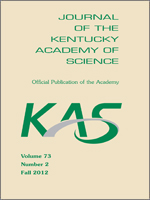Spicebush (Lindera benzoin L.) is a small native shrub that grows in the moist, understory areas of Appalachia and has potential as a new niche crop for small farmers. Native Americans and early settlers used this plant traditionally as a tea, and used the berries for jam, to spice food, and possibly for health benefits. Native spicebush patches may serve an important role in forest ecosystems in terms of fruit production for animals, soil erosion control, and enhancing insect biodiversity. Spicebush may also serve to hold ecological niches by outcompeting invasive plants compared to those in unchallenged areas. Genetic diversity of native spicebush populations in Kentucky has not been examined. The objective of this study is to determine the genetic diversity in spicebush populations in Kentucky using simple sequence repeat (SSR) DNA marker systems. Leaf samples were collected from 120 spicebush plants in the forests at the Kentucky State University Environmental Education Center (EEC), at a location near the Kentucky River, and at Cove Spring Park. DNA was extracted using the DNAmite Plant Kit. Primers A7, A115, B105, B122, C4, and C10 were used to amplify SSR products that were separated with a 3130 Applied Biosystems capillary electrophoresis system. The software program Power Marker was used to examine genetic relationships among genotypes. The SSR markers generated showed high genetic variation among the spicebush genotypes with the observed heterozygosity at 0.78. A number of selections with unique genotypes should be sampled and propagated for study in the KSU germplasm collection for potential cultivar development.
How to translate text using browser tools
1 September 2012
Genetic Diversity in Kentucky Spicebush Populations using Simple Sequence Repeat Markers
Re'Gie Smith,
Kirk W. Pomper,
Jeremiah D. Lowe,
Jacob Botkins,
Sheri B. Crabtree
ACCESS THE FULL ARTICLE
genetic diversity
Lindera benzoin (L.)
microsatellites
Perennial shrub
simple sequence repeat (SSR)
Spicebush





